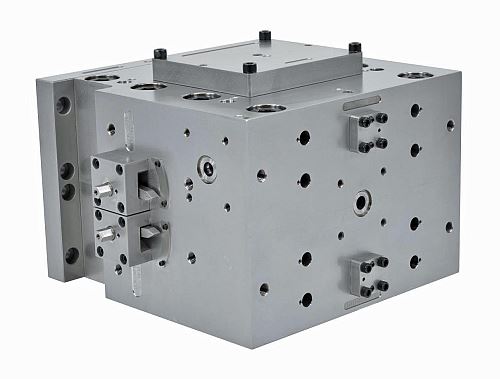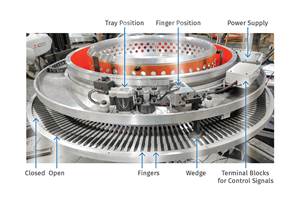EXTRUSION: Feedblock Fine-Tunes Layers, Balances Velocities
Device is adjustable in-line and is available with larger than usual channel widths to reduce shear stress and interfacial instability.
A next-generation coextrusion feedblock from Nordson Corp. reportedly enables processors of film, sheet, and coatings to fine-tune individual layers as well as accommodate changes in layer ratio, and to adjust the tuning system without removing the feedblock from the production line. Nordson will introduce the patent-pending technology at K 2016, along with the availability of feedblocks with wider than standard flow channels that are said to reduce shear stress and enhance end-product quality and consistency.
The EDI Ultraflow V-T feedblock has separate devices for fine-tuning layer stability and thickness uniformity, and both are capable of being adjusted without stopping production. As in the widely used Ultraflow V feedblock, one of these devices is a pair of “combining planes” (located where the outer-layer melt streams join the core layer in the central flow channel) that fine-tune the overall structure by adjusting the gaps at the point of layer combination. What is new is a pair of “profiling actuators” (located opposite the combining planes) within which are mounted interchangeable “profile bars” that fine-tune the thickness uniformity of the individual layers (see schematic). For coextrusion of more than three layers, additional tuning devices are placed farther downstream, where more melt streams join the central structure.
“Because the profiling actuators are large in diameter, they accommodate wider profile bars and enable them to be positioned either close to or farther from the layer combining point,” says Sam G. Iuliano, business development manager for polymer dies. “This provides more area for tuning layer thickness uniformity and thus makes possible more accurate and effective tuning. In addition, changing the position of the profile bars dramatically changes the result, allowing for significant process refinements to be made on-the-fly.”
The positioning of the profile bars with respect to the combining point is adjusted by rotating the profiling actuators. This is accomplished by turning nuts on the outside of the feedblock in accordance with a position indicator and does not entail stopping production.
The profile bars are available with various surface configurations, including a standard bar with a uniform raised surface and others designed to correct such issues as heavy end flow, heavy center flow, or “M” or “W” patterns. The bars are installed in dovetail grooves in the surface of the profiling actuators. A cover plate in the feedblock provides access for replacing one set of bars with another.
“Adjusting the profiling actuators in the Ultraflow V-T feedblock makes it possible to influence the distribution of a particular layer,” states Iuliano. “If further adjustment is necessary, one can replace the profile bars by briefly stopping production, without having to remove the feedblock from the extrusion line.”
Nordson will specify a feedblock whose flow channel differs in size from the standard 4 in. (100 mm), with widths available from 2 in. (50 mm) up to 7 in. (180 mm) depending on the width of the product to be extruded. Larger-volume feedblock channels reduce the shear stress levels at the layer interfaces and a wider feedblock channel contributes to a more consistently on-specification product. In the case of a 100-in. (2,540-mm) die, for example, the spreading ratio is 25:1 for a 4-in. feedblock channel but only about 14:1 for a 7-in. channel.
“As in the Ultraflow V feedblock, the combining planes in the new Ultraflow V-T system combine polymers in a parallel-path manner, achieving optimal layer ratio stability throughout the structure,” Iuliano explains. “Their ability to be adjusted ‘on the fly’ increases uptime and allows for greater end-product versatility.”
The Ultraflow V-T feedblock is available with Nordson’s optional selector spool that allows the layer sequence to be pre-arranged upstream of the combining point, without removing the feedblock from the production line.
Related Content
How to Decrease the Extrudate Temperature in Single-Screw Extruders
In many cases, decreasing the discharge temperature will improve product quality and perhaps even boost rate. Here are ways to do it.
Read MoreNew Blown-Film Cooling Technologies Set to Debut at NPE2024
Cooling specialist Addex to roll out new auto-profiling air ring for rotating dies, and new single-plenum air ring.
Read MoreWhat You Need to Know About Roll-Cooling Design
Cooling rolls might not look like high-tech machines, but the fact is there is a surprising amount of technology involved in their design, manufacture and use. Here’s what you need to know.
Read MoreUse a Process Assessment to Determine the Benefits of Screw-Design Modification
This type of analysis will provide the converter with a clear picture of whether changes to the screw could provide economic gains through increased rate, yield, and quality.
Read MoreRead Next
Beyond Prototypes: 8 Ways the Plastics Industry Is Using 3D Printing
Plastics processors are finding applications for 3D printing around the plant and across the supply chain. Here are 8 examples to look for at NPE2024.
Read MoreFor PLASTICS' CEO Seaholm, NPE to Shine Light on Sustainability Successes
With advocacy, communication and sustainability as three main pillars, Seaholm leads a trade association to NPE that ‘is more active today than we have ever been.’
Read More
























